Is the bloodbath over?
Many investors are asking this question about growth stocks.
As you likely know, the past couple of months have been rough on fast-growing tech stocks—one of the key areas we focus on at RiskHedge. After posting a record year in 2020, many growth tech stocks have given back a lot of gains.
“Growth” is a catch-all label that lumps together many fast-growing sectors of the stock market. It often pays to take a step back and examine how each of these sectors is performing on its own. So today, I’ll walk you through what’s going on in a few different growth sectors.
This is an important exercise. As you’ll see, there’s a separation happening under the surface. We’ll look at two growth subsectors that look like they’ve bottomed and could begin moving higher... and two others that look like they may have further to fall.
First, let’s kick things off by looking at the S&P 500.
-
The S&P 500 is the world’s most important stock index…
You can see below that the S&P 500 hit record highs two weeks ago.
It then sold off at the beginning of last week.
The good news is that it closed the week strongly. As you can see below, it bounced off its 50-day moving average. It also reclaimed its 10-day moving average.
In other words, the S&P 500 is still in an uptrend across all time frames.
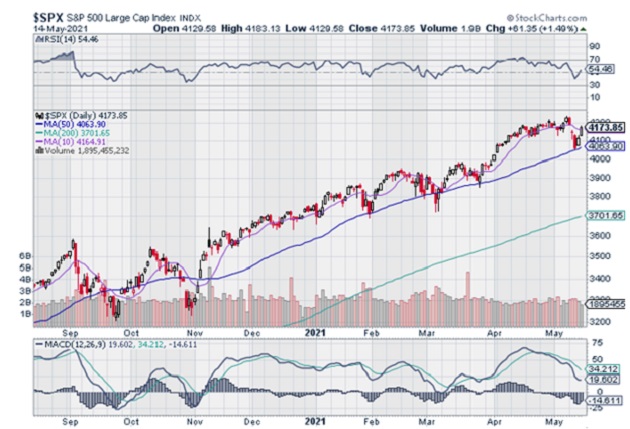 Source: StockCharts
Source: StockCharts
-
We’re also beginning to see signs of strength across “riskier” groups of stocks...
The next chart shows the performance of the iShares Russell 2000 ETF (IWM) over the past year. This fund invests in smaller stocks.
Small caps are riskier than large stocks like Walmart (WMT), Nike (NKE), and McDonald’s (MCD). Because of this, the IWM can tell you a lot about investor appetite for risk. In short, when IWM is rising, it suggests a constructive environment for growth stocks.
You can see that the IWM has been trading sideways since early February.
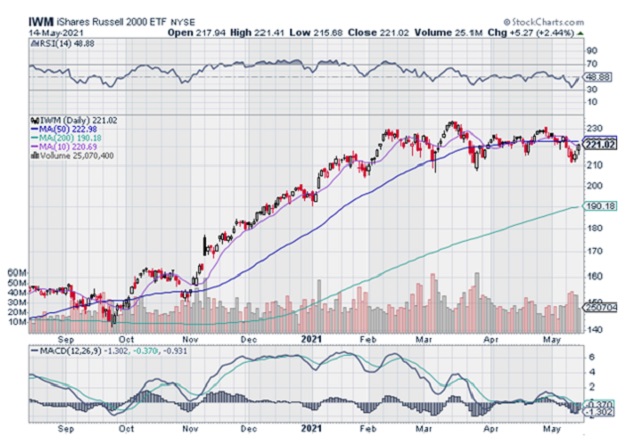 Source: StockCharts
Source: StockCharts
Small-cap stocks had the opportunity to roll over last week, which would have been a bad sign for the broad market.
But that hasn’t happened. IWM continues to hold above its key support level that’s been in place since February.
-
Still, this doesn’t mean you should dive headfirst back into growth stocks…
In choppy environments like today, you want to be selective about the stocks you buy. And certain pockets of the market are displaying more strength than others.
This next chart shows the performance of the iShares Nasdaq Biotechnology ETF (IBB). Biotech pulled back along with the rest of the market in February, and again earlier this month. It briefly broke below its 200-day moving average last week.
Traders use the 200-day moving average to identify longer-term trends. Generally, stocks with rising 200-day moving averages are in “uptrends” while stocks with falling 200-day moving averages are in “downtrends.”
As you can see, IBB’s 200-day moving average (in teal) is flat—which suggests we’re in a choppy market with no clear trend. IBB reclaimed its 200-day moving average on Friday—which is an important step in any bottoming process.
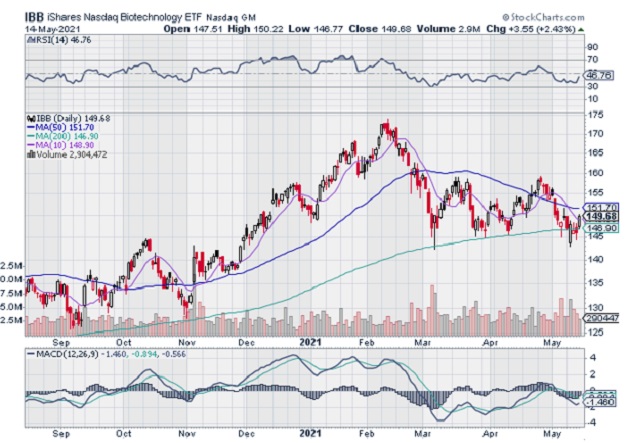 Source: StockCharts
Source: StockCharts
Like small-cap stocks, biotech stocks are on the riskier end of the spectrum. Many biotech companies haven’t even generated their first sale yet. Some haven’t even completed development of their first drug.
Because of this, biotech is often the hardest-hit industry during market pullbacks. Biotech stocks also deliver some of the biggest gains during rallies.
This makes them a great gauge of investor sentiment.
-
Medical device stocks also displayed strength last week…
You can see what I mean below.
This chart shows the performance of the iShares U.S. Medical Devices ETF (IHI), which invests in a basket of medical device stocks.
Medical device companies make products that help diagnose, prevent, and cure diseases. They sell everything from artificial joints to robotic surgery systems.
They’re basically tech companies dressed up as healthcare companies. Like “regular” tech companies, many medical device companies enjoy rapid growth.
In short, they’re growth stocks in disguise. And you can see that medical device stocks are still in a strong uptrend despite their recent sell-off.
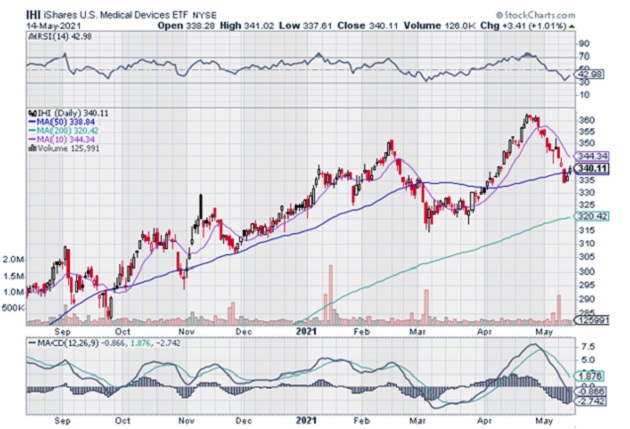 Source: StockCharts
Source: StockCharts
While biotech and medical device stocks have strong setups…
-
I suggest being patient with two other growth sectors…
Green energy stocks aren’t showing many encouraging signs yet.
This chart shows the performance of the iShares Global Clean Energy ETF (ICLN), which invests in green energy stocks.
ICLN has yet to reclaim its 200-day moving average.
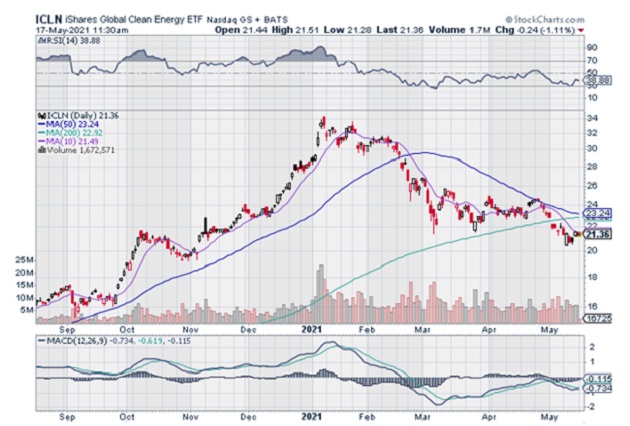 Source: StockCharts
Source: StockCharts
Now, this doesn’t necessarily mean clean energy stocks will keep falling.
But I don’t expect them to lead the market higher any time soon.
It’s a similar story with genomics stocks. The chart below shows the performance of the ARK Genomic Revolution ETF (ARKG).
Like clean energy stocks, genomic stocks are lagging.
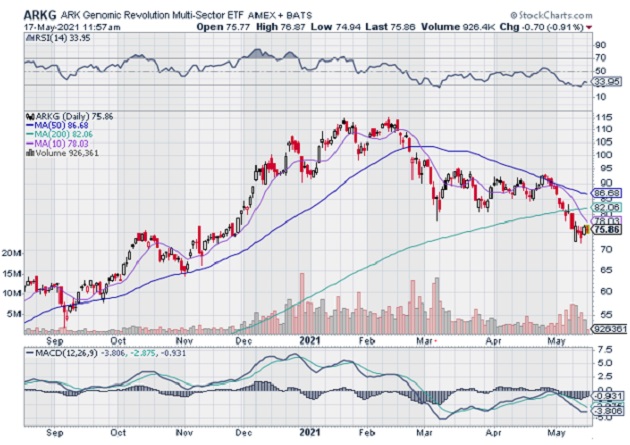 Source: StockCharts
Source: StockCharts
For reasons I’ve explained, I’m a big believer in genomics stocks, and I think they’ll eventually soar hundreds of percent. But I’m in no rush to buy a group of stocks that’s been lagging the market. There are simply better opportunities out there.
-
That brings me to my #1 idea today…
I’ve found a “pre-IPO” computer vision play… one that’s leading the way for self-driving cars.
This opportunity is currently in a special window where you can buy “pre-IPO” shares. Don’t let that deter you. “Pre-IPO” simply means everyday investors can get in on this explosive play BEFORE it goes public.
This isn’t a private placement or anything like that. All you need is this ticker and a regular brokerage account to invest in it. This company, rumored to be Tesla’s main supplier in self-driving cars, will likely go public in late May or June. Or July at the very latest.
That means you only have weeks, or quite possibly just days, to get your money into this opportunity before the IPO. I can’t give too many details here. If you’re interested, go here to read my brand new briefing on this opportunity.
Justin Spittler
Chief Trader, RiskHedge






